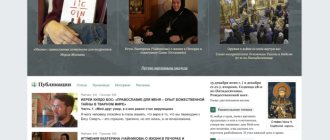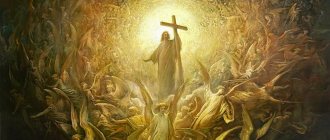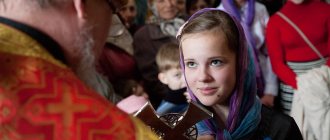Features of Orthodox doctrine
Main religious directions: x Christianity: Orthodoxy
This religion, one of the largest in the world, widespread among many peoples of the world speaking different languages, has existed for almost two millennia. It is difficult to find a corner of the earth where Christian missionaries are not working, trying to convert “lost” souls to their faith. Missionary work is bearing fruit. Millions of people around the globe are adherents of Christianity.
The Christian religion is not one. like other religions, it falls into a number of independent directions, the most significant of which are Catholicism, Orthodoxy, and Protestantism. While preserving basically the orthodox provisions of Christian dogma, these directions differ from each other in their unique interpretation of some dogmas and individual features of the cult. In order to clearly imagine the common ground that underlies the various Christian directions, as well as the differences that they have, it follows directly turn to these areas, get acquainted with their main features
Orthodoxy
Currently, there are 15 autocephalous (independent) churches in the world: Constantinople, Alexandria, Antioch (Syria, Lebanon), Jerusalem, Russian, Georgian, Serbian, Bulgarian, Cypriot, Hellenic (Greek), Albanian, Polish, Romanian, Czechoslovakian, American In addition, there are two autonomous Orthodox churches: Finnish since 1957 and Japanese - since 1970. All Orthodox churches have common doctrine and cult, while they retain canonical independence. The Patriarch of Constantinople, if considered ecumenical, is understood only as “first among equals” ", and he is not given the right to interfere in the activities of other Orthodox churches.
The limits of independence of autocephalous churches are determined by an agreement with the autocephalous church that granted it autonomy. The heads of autonomous churches are elected by local councils with their subsequent approval by the patriarch of the autocephalous church.
Administratively, autocephalous churches are divided into exarchates, dioceses, vicariates, deaneries, parishes. Thus, the Russian Orthodox Church has 4 exarchates (Ukrainian exarchate, exarchates of Western Europe, Central Europe, Central and South America), 76 dioceses (in the USSR and abroad ), 11 vicariates In addition, a number of autocephalous churches have missions, deaneries, and metochions under other Orthodox churches
System of organization and management of Orthodox churches
Orthodoxy, like Protestantism, does not have a single control center like the Vatican. Autocephalous churches are headed by patriarchs (archbishops, metropolitans), elected by local councils for life. There are synods under the patriarchs. For example, the synod of the Russian Orthodox Church consists! of six permanent members and three non-permanent members, summoned to the session according to the list. Management of exarchates is carried out by exarchs, dioceses - by diocesan bishops, under whom, in some cases, diocesan councils are created. Dioceses consist of districts and parishes. In the Russian Orthodox Church, parishes are headed by church councils elected at general meetings of believers, which perform all the administrative and economic functions of the community. Orthodox churches from the 8th century. do not hold Ecumenical Councils (the last council at which the Orthodox churches participated was the Second Council of Nicaea in 783-787). Each of them, at local councils, approves canonical rules, revises or supplements the lists of saints, and determines the forms of attitude towards heresies and schisms. For example, at a local council of the Russian Orthodox Church in 1971, the anathema towards the Old Believers was lifted. All Orthodox churches are characterized by a hierarchical principle of management, that is, the principle of consistent subordination of the lower clergy to the higher. All clergy are hierarchically divided into higher, middle and lower. In addition, the clergy is divided into black (monastic) and white (married)
Currently, in preparation for the Ecumenical Council of Orthodox Churches, pan-Orthodox meetings are being held. A preliminary catalog has been developed for them! topics for discussion. Among them, it is proposed to consider questions about the sources of divine revelation, about the more active participation of the laity in church life, about the compliance of church rules on fasting with the requirements of modern life, about overcoming obstacles to the marriage of representatives of different faiths, about the attitude towards various violations of church canons, etc. Among the 15 autocephalous churches, the most numerous and influential is the Russian Orthodox Church. It has over 7 thousand churches, 16 monasteries, among which the Groitse-Sergius Lavra, Pochdev Lavra, Pskov-Pechsrsky, Zhirovitsky, Uspensky, Odessa Uspensky, Gornitsky (Jerusalem) and other monasteries are especially famous; two theological academies, three theological seminaries, a correspondence education sector, and graduate school. The Moscow Patriarchate publishes monthly magazines, theological works, and various liturgical literature. In production workshops, religious objects (candles, crosses, etc.) are manufactured.
Features of Orthodox doctrine
The basis of Orthodox dogma is the Niceno-Tsargrad Creed, approved at the first two Ecumenical Councils of 325 and 381. The 12 members (paragraphs) of this creed formulate ideas about God as a creator, about his relationship to the world and man. This includes ideas about the trinity of God, the incarnation, atonement, resurrection from the dead, baptism, the afterlife, etc.
The Orthodox Church declares all the basic provisions of faith (dogmas) to be absolutely true, indisputable, eternal, unchangeable, communicated to man by God himself and incomprehensible by reason. “Man,” repeat Orthodox theologians, “cognizes God not so much with his mind as with his entire inner life” (Journal of the Moscow Patriarchate, 1966, No. 4, p. 40). Therefore, they declare, the basis of his knowledge is faith. All Orthodox churches consider their primary duty to “inviolably preserve the deposit of faith entrusted to the original church, without adding anything to the dogmatic heritage of the universal church and without subtracting anything from it.” Only those provisions of the doctrine that were approved by the first seven Ecumenical Councils are considered true. As for the Catholic dogmas established later (about the infallibility of the pope, about purgatory, about the felioque, about the immaculate conception of the Virgin Mary and her bodily ascension to heaven), they are declared by all Orthodox churches to be erroneous, contradicting “holy scripture” and “holy tradition.” . The refusal of Protestant churches to reject the majority of sacraments, to divide believers into laity and clergy, and to recognize the exclusive role of the church in the matter of personal salvation is also considered an error.
Orthodox churches pay great attention not only to proving the infallibility of their doctrine, but also to promoting it among believers. They are required to know by heart the symbol of faith and its choral performance during the liturgy. However, the main means for believers to assimilate all the main points of doctrine in Orthodoxy is the cult and the entire system of worship associated with it.
Orthodoxy emerged as a religious expression of the peculiarities of the development of the feudal social system of Byzantium, in comparison with the countries of Western Europe. Such characteristic features of the Byzantine Empire as the slow process of feudalization, the strong despotic power of the emperor-monarch, a strong and stable central state apparatus, left their mark on the content of the doctrine, and on the nature of the activities, and on the form of church government of Orthodox Christianity.The Orthodox Church considers itself the custodian of the covenants of Apostolic Christianity. In reality, Orthodoxy differs significantly from early Christianity in the 1st and 2nd centuries. n. e. If early Christianity was the religion of slaves, then Orthodoxy serves the exploiters. Its characteristic features are conservatism, fundamental irrationalism and mysticism, manifested in the doctrine, in ritual practice, in the activities of various Orthodox saints, etc. These features of Orthodoxy are explained by the social conditions that led to the division of Christianity into Orthodoxy and Catholicism.
If the relatively independent political position of Catholicism allowed it to supplement Christian dogma with a number of new provisions in which the Catholic clergy were interested (for example, the dogma of the existence of purgatory, the dogma of the infallibility of the Pope, etc.), then, on the contrary, strict control by the monarchical state forced Orthodoxy humbly renounces dogmatic and ritual innovations and even takes credit for its conservatism.
The very name of the Eastern Church - Orthodox - which was established for it after the division of churches, in contrast to the Western - Catholic (although previously both churches simultaneously called themselves Catholic, Ecumenical, and Orthodox), reflected primarily the desire of Orthodox churchmen to emphasize their orthodoxy and orthodoxy .
The doctrine of the Orthodox Church is set out mainly in the “symbol of faith” adopted at the Nicene (325) and Constantinople, or Constantinople, (381) Ecumenical Councils and supplemented by the decrees of subsequent Ecumenical Councils, ending with the seventh (787). After the formal division of the churches (in 1054), the foundations of Orthodoxy were repeatedly set forth in so-called symbolic books, which included the famous “Long Christian Catechism1 of the Orthodox and Catholic Eastern Churches,” compiled by Metropolitan Philaret Drozdov (1782-1867).
The doctrine of Orthodoxy is a set of dogmas that characterize it as an anti-scientific and reactionary worldview. Dogmas, from the point of view of Orthodox churchmen, are unchangeable “truths” that are the subject of faith and which can neither be reduced nor multiplied. Dogmas are taught to people by the church and form the subject of a special pseudoscience - Orthodox theology.
The sources of the doctrine of Orthodoxy are “sacred scripture” and “sacred tradition”.
“Holy Scripture” is the books of the Old and New Testaments. Orthodox churchmen consider 22 books of the Old Testament and all books of the New Testament to be canonical. The church declares these books to be inspired by God, that is, written by prophets and apostles through “direct illumination and enlightenment from the holy spirit.” The right to interpret the Bible, according to Orthodoxy, belongs only to the church.
“Holy tradition” consists mainly of “symbols of faith”, decrees of Ecumenical and local councils, the works of the so-called “fathers” of the church, such as Athanasius the Great, Basil the Great, John Chrysostom, Gregory the Theologian, etc., whom the Orthodox Church proclaims by their religious teachers.
The basis of Orthodox dogma is the anti-scientific idea of a God unknowable by reason, one, but at the same time trinitarian, appearing in three persons (hypostases): God the Father, God the Son and God the Holy Spirit.
The main person of the mystical trinity - God the Father - is considered by churchmen as a spirit - “eternal, all-good, all-knowing, all-righteous, all-powerful, all-present, unchangeable, all-satisfied and all-blessed.” Orthodoxy considers God the creator of the visible world - nature and a special, supernatural, invisible world, where, on the one hand, there are good disembodied spirits - angels (messengers), "gifted with mind, will and power", and on the other hand, evil spirits - devils , that is, “slanderers and seducers.” God also acts as the creator of man and his immortal soul, which after the death of a person goes to the afterlife: heaven or hell.
All nature and social life, according to Orthodox doctrine, are subordinated to “divine providence.” The order of life is established once and for all by God. Miracles supposedly constantly occur in nature, which are “the natural revelation of God.” The second person of the trinity is God the Son - Jesus Christ, who, according to Christian mythology, descended from heaven to earth, was miraculously born of the Virgin Mary, lived and preached on earth for 33 years, then, under the Roman governor Pilate, was captured and crucified on the cross.
Resurrected after death, he ascended to heaven, where he is preparing to come to earth a second time to judge the living and the dead.
Finally, God is the holy spirit. This is the third person of the trinity. Orthodoxy rejects the Catholic dogma of the procession of the Holy Spirit from God the Father and God the Son (filioque) and considers it to come only from God the Father.
According to the teachings of the church, each member of this trinity is an independent god; at the same time, all three are one god. Theologians themselves cannot explain what it is. The Orthodox book “Catechetical Teachings” says: “We must believe in the Holy Trinity, but we must not explore how God is one in three persons.” Not to think, but to blindly believe in nonsense - that’s what the church demands!
The central place in Orthodox doctrine is occupied by the dogma of the sinfulness of all people and their salvation through the performance of rituals and observance of certain standards of behavior. This dogma of Orthodoxy and the social and ethical principles arising from it are extremely reactionary and anti-scientific in nature.
Orthodox clergy preach that the source of evil in the world is not the exploitative system, but the “fall of the first people” who violated the commandment of God, were consequently deprived of divine support and turned into egoists who distorted the idea of the purpose and meaning of life.
In its teaching about so-called salvation, Orthodoxy occupies a middle ground between Catholicism and Protestantism. On the one hand, Orthodox churchmen reject the absolute nature of predestination, believing that man has free will, which, in their opinion, is the cause of the evil reigning on earth. On the other hand, the Orthodox Church denies Catholic ideas about salvation, according to which a believer can earn eternal life in the kingdom of heaven by his good deeds in favor of the church, and if there are a shortage of such, even borrow them from the stock of “super-duty” deeds of various saints.
Rejecting the Catholic dogma about the “extraordinary” merits of saints, Orthodoxy claims that a believer can earn the kingdom of heaven if he earnestly, with tears, prays that God will accept his prayers, alms and other good deeds as merit and grant him forgiveness of sins. Orthodox preachers teach that the main merit of people before God lies not simply in observing moral commandments, not in writing theological treatises, but in tireless, frantic prayers. Their ideal is a weeping mystic-pagan, an ascetic monk who tortures his flesh. Preaching asceticism and detachment from the earthly world is one of the characteristic features of Orthodoxy.
Orthodoxy rejects Catholic ideas about the so-called purgatory, into which the souls of dead people allegedly end up on the eve of the Last Judgment and subsequent transition to heaven or hell. However, the germ of faith in purgatory in Orthodox doctrine is preserved in the form of the idea that after death a private judgment is carried out on the soul of a believer, after which the souls of the righteous will face eternal bliss, and the souls of sinners will suffer until the Last Judgment. The Orthodox Church claims that its prayers for the souls of the dead can free them from torment and ensure unhindered access to heaven. Associated with a similar idea is the Orthodox custom of the so-called sorokoust, that is, a forty-day funeral church service.
Orthodoxy: creed, cult, organization.
In the previous section, we analyzed the general patterns of the formation of the Christian church and identified the features of the church as a social organization. This section discussed the general logic of the formation of a church organization. In real history, Christianity has never represented a single organization. In numerous provinces of the Roman Empire, it acquired its own specificity, adapting to the conditions of each region, to local culture, customs, traditions, social relations, etc.
The political and cultural division of the Roman Empire already in the 3rd - 4th centuries led to the separation of the Eastern and Western churches. In the east of the Roman Empire, four autocephalous (independent) churches were formed: Constantinople, Alexandria, Antioch, and Jerusalem. Soon the Cypriot and then the Georgian Orthodox churches separated from Antioch. In the middle of the fifth century, not recognizing the decision of the Council of Chalcedon, the Armenian Gregorian Church became isolated. The biggest blow to the unity of Christianity was dealt on June 16, 1054, when the head of the Western Church, the Pope, and the formal head of Orthodoxy, the Patriarch of Constantinople, declared an anathema against each other, that is, they subjected each other to a church curse.
In fact, the split of Christianity into two main directions - Orthodoxy and Catholicism - occurred much earlier, after the collapse of the Roman Empire at the beginning of the 5th century. to East and West. Orthodoxy was formed in the Eastern part of the Roman Empire, in Byzantium. Catholicism - in the Western part of the Roman Empire. Byzantium at that time was a strong centralized state. The Emperor of Byzantium considered himself the head of the entire Roman Empire. Constantinople was declared the capital of the Roman Empire. In the VI century. The head of the Byzantine Church, the Patriarch of Constantinople, after Byzantium liberated Rome from the barbarians, began to call himself the ecumenical partarch, that is, the head of both the Eastern and Western churches. The rivalry between the head of the Roman Catholic Church, the Pope, and the Patriarch of Constantinople for power over Christians continued for many centuries. This struggle went on with varying degrees of success. After the conquest of Italy by the Frankish emperor Charlemagne (late 7th - early 8th century), the Pope left the jurisdiction of the Byzantine emperor and the process of strengthening his position began. Byzantium at this time was under attack from the Arab Caliphate and lost a number of important territories in which the consolidation of independent church organizations was taking place.
Currently, there are 15 autocephalous (independent) Orthodox churches: Constantinople, Alexandria, Antioch, Jerusalem, Russian, Georgian, Serbian, Bulgarian, Cypriot, Hellenic (Greek), Romanian, Albanian, Polish, Czechoslovak, American. Autocephalous churches have exarchates, dioceses, deaneries, metochions, and missions in various countries. For example, the Russian Orthodox Church has exarchates in Central and Western Europe, a diocese in Belgium, deaneries in Austria, Japan, Hungary, metochions in Belgrade, Beirut, Sofia, etc. In turn, other autocephalous Orthodox churches have their representations in territory of Russia and CIS countries.
Many of the autocephalous churches have autonomous Orthodox churches. The limits of independence of autonomous churches are determined by an agreement with the autocephalous church that granted them autonomy. The heads of autonomous churches are elected by local councils with their subsequent approval by the patriarch of the autocephalous church. Patriarch D of Constantinople retains the title of “Ecumenical Patriarch,” but he is not given the right to interfere in the activities of other Orthodox churches. In other words, the Patriarch of Constantinople is considered by authority to be “first among equals.”
All Orthodox churches have common doctrine, cult and canonical activities. The basis of Orthodox dogma is the Nicene-Constantinopolitan Creed, adopted at the first two Ecumenical Councils (325 - Nicaea and 381 - Constantinople (Constantinople in ancient Russia was called Constantinople, hence the name Nicene-Constantinople Creed).
This creed was approved in the form of 12 members (paragraphs), containing dogmatic formulations of the main provisions of the doctrine of God as the creator, his relationship to the world and man, the trinity of God, the incarnation, atonement, the resurrection from the dead, the saving role of the church, etc. d. An Orthodox person calls himself Orthodox because he proclaims his duty to preserve intact “the deposit of faith entrusted to the original church, without adding or subtracting anything from the dogmatic heritage of the universal church.” In reality, this means recognizing as true only those provisions of the doctrine that were approved by the first seven Ecumenical Councils.
We have already noted the decisive role of the first two councils in the formation of Orthodox doctrine. The subsequent five councils introduced certain clarifications and clarifications into the dogmatic formulations of the Nicene-Constantinopolitan Creed. At the Third Ecumenical Council of Ephesus (431), six rules were approved to protect the dogma of the Incarnation in connection with the attempt of supporters of the Patriarch of Constantinople Nestor to weaken the divine essence of Jesus Christ. Woman, the Nestorians argued, gave birth to man, not God. And only by the inspiration of the Holy Spirit did divinity move into him.
At the Fourth Ecumenical Council of Chalcedon (451), the main attention was paid to substantiating the dogma of atonement and incarnation. At this council, a bias in the interpretation of the divine-human character of Jesus Christ in the opposite direction appeared. Monophysites (one-naturalists) declared that in Jesus human nature was embodied by the divine, and therefore recognized in him only one divine nature. The Council approved the dogma of the Incarnation in such a wording that Jesus Christ should be considered both as true God and as true man, eternally born from God the Father according to divinity, he was born from the Virgin Mary according to humanity, divinity and humanity were united in him as a single person “undoubtedly and unchangeably, inseparably and inseparably."
The fifth, sixth and seventh Ecumenical Councils were devoted to resolving disputes about the form in which Jesus Christ should be depicted, and whether it was even possible to use images of sacred persons and worship of these images in churches. The Fifth Ecumenical - Second Council of Constantinople (553) obliged to depict the Son of God in human form, and not in the form of a lamb. The Sixth Ecumenical Council (Elvira) established the rule that there should be no objects of veneration or worship on the walls of churches. The Seventh Ecumenical - the second Nicene (787) approved the rule according to which the depiction of sacred persons and events and the worship of them were considered necessary.
So, as a result of the first seven Ecumenical Councils, the Orthodox doctrine was formed. This creed is reproduced daily by Christian believers in the form of a prayer - “I Believe”, as a sign of recognition of the main provisions of the creed. Briefly, the content of the Orthodox doctrine can be presented as follows:
Orthodox believe in one God, who created the whole world, including man. This God, according to Orthodox concepts, represents the identity of three equal persons: God the Father, God the Son and God the Holy Spirit; into the original sin, which was committed by the first people Adam and Eve; at the second coming of Jesus Christ - God the Son, who became man (that is, took on human form, being born through the virgin birth from the Virgin Mary) and voluntarily offered himself as a sacrifice for the sins of mankind (was crucified on the cross and was resurrected on the third day, and After 40 days he ascended into heaven) and will come again a second time in power and glory to judge the living and the dead and establish his eternal kingdom on earth as in heaven, in which the righteous will bliss and sinners will be tormented forever. Orthodox believe in the immortality of the soul, in the existence of hell and heaven, where the souls of the dead reside until the Last Judgment. According to the Orthodox faith, salvation can only be achieved within the framework of the church, which is the “mystical body of Jesus Christ,” a mediator between God and man.
In Orthodoxy, like any other religion, a system of cult actions is closely connected with dogmatic dogma. The basis of these religious actions are seven main rites - sacraments. These cultic actions are called sacraments by theologians because in them “under a visible image the invisible divine grace is communicated to the believers.” The Orthodox recognize seven sacraments: baptism, communion (Eucharist), repentance (confession), confirmation, marriage, unction (unction), priesthood.
The sacrament of baptism is one of the main sacraments symbolizing the acceptance of a person into the bosom of the Christian church. The rite of baptism takes place in the form of ablution. In the Orthodox Church, a baby is immersed in water three times. An adult is simply washed with water. Through the sacrament of baptism, theologians teach, a person’s original sin is forgiven (and if an adult is baptized, then all other sins). Performing the rite of baptism means introducing a person “into the bosom of the church.” It is after performing this rite that he becomes a Christian - Orthodox, if this rite is carried out according to the Orthodox canon, Catholic - if according to the Catholic canon, etc. Naming is also associated with the rite of baptism. As a result of this ritual, the newborn receives his own name. According to tradition, this name is associated with the name of the saint to whom the day on which the baptized person was born is dedicated.
The second most important rite, but no less important, is the sacrament thanksgiving sacrifice). According to Christian doctrine, the rite of communion was established at the Last Supper by Jesus Christ himself, who thereby “gave praise to God and the Father, blessed and sanctified the bread and wine and introduced his disciples, and in their person, all believers to God.” “Eat my body, drink my blood as a sign of closeness to me,” Jesus Christ commanded. With this in mind, the church performs the sacrament of communion. The specific content of this ritual is that believers are given specially baked bread to eat - prosphora, which they wash down with a sip of red wine from a special vessel - a chalice. It is believed that during this rite the sacrament of transubstantiation is performed, that is, the prosphora bread turns into the body of Jesus Christ, and the wine into blood.
Communion is given great importance in the Orthodox Church. This rite is accompanied by a number of other sacraments. The clergy insists that every believer receive communion at least once a year. It is believed that only on the basis of the sacrament of communion can a person maintain an inextricable connection with Jesus Christ.
The performance of the sacrament of repentance (confession) is an indispensable attribute of the religious life of an Orthodox Christian. The performance of the sacrament of repentance includes two important acts. The first is confession of sins. Confession of sins is a report by believers to the clergy for violating God's commandments or church regulations. It is believed that confession of sins spiritually cleanses a person, removes the burden of sins from him, and keeps him from all kinds of sins in the future. Therefore, an important component of the sacrament of repentance is the ritual of “absolution of sins,” which only a special person - a clergyman of a certain rank - is authorized to perform. Initially, in early Christianity, repentance was public. Starting from the 13th century, “secret confession” was introduced. And the priest must observe the secret of confession. The Church guarantees the preservation of this secret. Violating the secret of confession is considered a great sin.
The sacrament of confirmation is also an important part of many cultic activities. In the Orthodox Church, confirmation occurs immediately after the rite of baptism. This sacrament takes place in the form of a cross-shaped smearing of the human body (forehead, eyes, nose, lips, ears, chest, arms and legs) with a special aromatic oil (myrrh). Before anointing, the priest reads a prayer for the sending of the Holy Spirit on a person. At the same time, he repeats the words “Seal of the Holy Spirit.” The meaning of this sacrament in the Orthodox catechism is interpreted as follows: “in order to preserve the spiritual pure Russian Orthodox Church: that received in baptism, in order to grow and strengthen in spiritual life, we need the special help of God, which is given in the sacrament of confirmation.”
The sacrament of marriage - church coverage of the ceremony of marriage or wedding - is also an important moment in a person’s religious life. From the point of view of Orthodox doctrine, the family is the primary unit of the spiritual community of people - the “home church.” A Christian is born in this church, through baptism he joins the universal church, receives a Christian education and dies as a Christian.
The wedding ceremony is structured in such a way as to emphasize the special importance of this event in the lives of young people. The priest greets the newlyweds in festive attire. The words of psalms are heard praising God, in whose name the marriage is celebrated. Prayers are read in which the clergyman asks God for blessings for the bride and groom, peace and harmony for the future family. Crowns are placed on the heads of those entering into marriage. They are offered to drink wine from the same cup. They are then led around the altar. At the same time, prayers are again offered to God. The spiritual meaning of this rite is that during the wedding, God's grace is poured out on the future spouses, which ensures an inextricable symbolic union based on love, fidelity and mutual assistance until the grave.
The sacrament of consecration of oil (unction) is performed on a sick person. The ritual consists of smearing the forehead, cheeks, lips, hands and chest with consecrated wooden oil - oil, accompanied by the reading of prayers in which the clergy ask God to grant the sick recovery. At the same time, the seven letters of the apostles are read, and seven litanies (petitions) are pronounced for the sick person. The spiritual meaning of this sacrament, according to the teachings of the church, is that the consecration of oil has healing power and cleanses the patient from sins.
The Orthodox Church attributes a special meaning to the sacrament of the priesthood. It is performed when a person is ordained to the clergy, that is, to one degree or another of the priesthood. In the Orthodox Church there are three degrees of clergy: the first (lowest) - deacon [(deacon, protodeacon, archdeacon, (in monasticism - hierodeacon)]); second (middle) - presbyter [(priest - priest, archpriest, protosbyter, (in monasticism - hieromonk , abbot, archimandrite)]; the third (highest) is the bishop (vicar bishop, ruling bishop, archbishop, metropolitan, exarch). Together, all these categories of clergy make up the church hierarchy. Each of the levels of the priesthood has its own distinctive features in the vestments, behind each of which certain rights and obligations are secured.
The sacrament of the priesthood is performed on the basis of a special rite of ordination - ordination, during which the hands of a superior clergyman are laid on the head of the initiate. It is believed that at the moment the bishop lays hands on the head of the person being ordained as a presbyter or deacon, divine grace is transferred to the latter, making him a mediator between God and people. The presbyter receives from the bishop the authority to perform all the sacraments, except the priesthood, and all divine services and rites. The deacon cannot independently perform the sacraments and divine services, but only helps serve the bishop and presbyter when they perform the sacraments during divine services. Bishops can only be consecrated by a council of bishops. Consecration to the patriarchate is carried out through a special rite - the enthronement by a council (meeting) of three other Orthodox heads of autocephalous churches after election to this position by the Local Council of the Orthodox Church.
In addition to performing the sacraments, the Orthodox cult system includes prayers, veneration of the cross, icons, relics, relics and saints. Prayers are a believer’s appeal to God or saints with his requests, complaints, gratitude, etc. Prayers can be mental or verbal, expressed in an appropriate verbal address to God or a saint. Prayers can be individual and collective. An example of congregational prayer is litany. During collective prayer, great importance is attached to certain ritual actions: kneeling, raising hands, closing eyes, etc.
Worship of the cross is one of the most important elements of the Orthodox cult. The cross is a symbol of the Christian faith. It is crowned with Orthodox churches, the robes of clergy, it is worn on the body by believers, and during prayers and services, believers and clergy make the sign of the cross (cross themselves). According to Orthodox teaching, the cross as a symbol was adopted by the Christian Church in memory of the martyrdom of Jesus Christ, who, as is known from the Bible, was crucified on the cross and thereby sanctified it with his blood. The cross is credited with magical saving power. The shape of the cross can be different: four, six (to depict the inscription nailed above the head of Christ) and eight-pointed (with the addition of a beam for the legs).
The cult of icons - painted or relief images of God the Father, God the Son, God the Holy Spirit, the Trinity, the Mother of God, saints, evangelists, etc. is widespread in Orthodoxy. It is believed that through these images a believer can come into contact with the characters depicted on them and turn to them with prayers. Some icons enjoy a special object of veneration. They are recognized as having a special miraculous power, because some miraculous events are associated with these icons. An example of such an icon is the icon of the Kazan Mother of God.
Orthodox believers also venerate holy relics. Relics, according to Orthodox teaching, are the remains of the dead, who by God’s will remained incorruptible and possessing the gift of miracles. Unlike Byzantine Orthodoxy, in which relics are understood only as incorruptible bodies, in Russian Orthodoxy the idea of relics as incorruptible bodies, as well as parts of the body, removed by the power of God from the universal law of corruption prevailed.
The cult of saints is closely related to the cult of relics. According to the teachings of the church, saints are persons who led a pious life, performed “exploits” for the glory of God, and after death were marked by the supreme gift of miracles, the ability to influence the destinies of people. Orthodox Christians believe that saints are mediators between God and people, heavenly patrons of those living on earth, and turn to them with requests for earthly matters. Canonization is carried out on the basis of the act of canonization. In the first centuries of Christianity, canonization occurred spontaneously, perpetuating the memory of martyrs, hermits, and confessors. Later, certain rules were developed, one of which is the acquisition of the relics of a given saint. Currently, issues of canonization in the Russian Orthodox Church are dealt with by a special commission, whose proposals are considered by the Holy Synod and decisions of Local Councils are made. The Orthodox canon contains a strict hierarchy of saints: angels, prophets, apostles, saints, martyrs, saints, and righteous people.
Holidays and fasts occupy an important place in the Orthodox cult In church calendars, every day is associated with the name of Jesus Christ, the Mother of God, saints, miraculous icons, and the cross. At the head of the holiday circle of the Russian Orthodox Church is Easter. Easter is the most revered general Christian holiday in Orthodoxy, established in memory of the resurrection of the son of God Jesus Christ crucified on the cross. Since the idea of resurrection is central to Christianity, the holiday dedicated to this event is given a central place. Orthodox theologians call it the “feast of feasts” and the triumph of celebrations. This holiday is celebrated on the first Sunday after the spring equinox and full moon. To calculate the day of Easter celebration, special tables are compiled - Easter.
Following Easter in importance are the so-called twelve holidays - the Nativity of Christ, Epiphany, Presentation, Annunciation, Transfiguration, Nativity of the Virgin Mary, Dormition of the Virgin Mary, Exaltation of the Cross, Entry of the Lord into Jerusalem or Palm Sunday, Ascension and Trinity. The twelve feasts are followed by five feasts, called great: the circumcision of the Lord, the Nativity of John the Baptist, the feast of Saints John and Paul, the beheading of John the Baptist, the protection of the Most Holy Theotokos. The remaining holidays are called patronal holidays. These are local holidays associated with thrones - a holy place in the temple, which is dedicated to one or another saint. In the Russian Orthodox Church, “Nikolin’s Day”, “Ilya’s Day”, the day of the “Kazan Mother of God” and others are widely spread.






